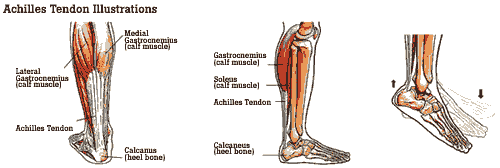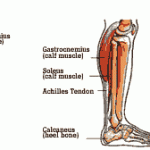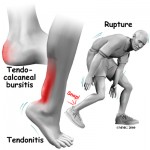The Achilles tendon is fibrous tissue that connects the heel to the muscles of the lower leg: the calf muscles. Leg muscles are the most powerful muscle group in the body and the Achilles tendon is the thickest and strongest tendon in the body. Contracting the calf muscles pulls the Achilles tendon, which pushes the foot downward. This contraction enables: standing on the toes, walking, running, and jumping. Each Achilles tendon is subject to a person’s entire body weight with each step. Depending upon speed, stride, terrain and additional weight being carried or pushed, each Achilles tendon may be subject to up to 3-12 times a person’s body weight during a sprint or push off.
Causes of Injury
Overuse, misalignment, improper footwear, medication side effects, and/or accidents can all result in Achilles tendon injuries. Multiple causes often contribute to the same Achilles tendon injury.
For example: a sudden increase in hill climbing, worn out shoes, and weak or tight calf muscles could all contribute to Achilles tendinosis and Achilles tendonitis.
 Overuse
- Too fast of an increase in athletic activities such as:
- Running or walking longer;
- Running or walking faster;
- Running or walking up and down more or steeper hills or stairs;
- More or more powerful “explosive†movements such as lunges, jumps, or  push off’s.
- The athletic activity by itself is not the problem, the problem is doing too much too quickly or resuming too quickly after a layoff.
- Types of injuries caused:
- Achilles tendinosis,
- Achilles tendonitis,
- Achilles tenosynovitis,
- Tennis Leg, or
- in the most severe cases: Achilles tendon rupture.
Misalignment
- Examples:
- Unequal leg length,
- Over or under pronation,
- Short or tight Achilles tendons or calf muscles,
- Disproportionably weak calf muscles, and
- Misshapen heel or other foot bones.
- Types of injuries caused:
- Achilles tendinosis,
- Achilles tendonitis,
- Achilles tenosynovitis,
- Tennis Leg, or
- in the most severe cases: Achilles tendon rupture.
Improper Footwear
- Examples:
- Shoes or sports shoes with too much or too little:
- Arch support,
- Cushioning,
- Motion control, and/or
- Heel support;
- High heels; and
- Worn out shoes or sports shoes.
- Types of injuries caused:
- Achilles tendinosis,
- Achilles tendonitis,
- Achilles tenosynovitis,
- Tennis Leg, or
- in the most severe cases: Achilles tendon rupture.
Medication Side Effects
- The Quinolone group of antibiotics
- Example: Ciprofloxacin (Cipro®, Baycip®, Cetraxal®, Ciflox®, Cifran®, Ciplox®, Cyprobay®, Quintor®).
- Type of injuries caused:
- Achilles tendinosis,
- Achilles tendonitis,
- Achilles tenosynovitis,
- Tennis Leg, or
- in the most severe cases: Achilles tendon rupture.
- Cortisone
- Cortisone is an indirect, rather than a direct, cause of Achilles tendon injury. Cortisone can make a weakened Achilles tendon feel too comfortable.  A patient who has received cortisone shots in or near the Achilles tendon may be able to overly stretch or strain their Achilles tendon without any pain – until they stretch or strain it to the point of rupture
- Contributing factor: the injury for which cortisone was prescribed.
- Type of injury caused: Achilles tendon rupture.
Accidents
- Examples:
- Crushed in a car or work accident; or
- Cut (lacerated) by a lawn mower or in a work accident.
- Type of injuries caused:
- Crushed Achilles tendon, or
- Lacerated Achilles tendon.
Preventing Injuries
The best way to prevent an Achilles tendon injury is to a) stay in overall good shape, and b) warm-up, stretch, and strengthen the Achilles tendons. The best way to prevent an Achilles tendon injury from getting worse is to address the injury immediately: it will get worse if not addressed.
Preventing Achilles tendon injuries can be viewed at two levels: general injury prevention and Achilles tendon specific injury prevention. General prevention relates to the steps a person can take to prevent any type of injury (including Achilles tendon injuries) when being active and working out. Achilles tendon specific prevention relates to steps targeted directly at the prevention of Achilles tendon injuries.
General Injury Prevention
Staying healthy and being in good shape are the best ways to prevent injuries. General steps to help prevent any type of injury include:
- Exercise regularly.
If you have not been working out regularly, check with a doctor before starting. - If you are not familiar with how to work out properly, read some fitness and workout books before starting, and/or consult with a trainer. Almost all gyms have trainers.
- Eat a balanced diet, drink plenty of water, and get enough sleep. If you cover these three bases, exercise will strengthen your body. If you don’t, whether you exercise or not, you will wear down.
- For example: in addition to teeth and bone issues, insufficient calcium could lead to tight muscles, resulting in excess Achilles tendon strain. The U.S. Institute of Medicine’s Recommended Dietary Allowance (RDA) and Dietary Reference Intake (DRI) is 1,000-1,200 mg of calcium and 700 mg. of phosphorus daily for adults. The right amount and proportion of calcium helps the body in several ways: 99% goes toward strengthening teeth and bones, but some helps with muscle contraction.  If a person’s diet provides too little calcium or too much phosphorus, their body siphons calcium out of teeth and bones and stops providing it to the muscles. Cola based soft drinks and some junk foods are high in phosphorous, unduly increasing the body’s need for calcium.
- Maintain a good weight, neither underweight nor overweight.
- Avoid smoking and excessive caffeine, alcohol, and drugs.
- Take care of any foot or leg growths or dislocations. Even a small growth on the foot, or a partial dislocation in the foot or leg, could throw off a person’s stride, which might strain a variety of foot and leg muscles and tendons (including the Achilles tendon). If you have a foot or leg injury, or any type of foot growth, see a doctor and have it treated before it contributes to other injuries..
- Spend as much of your exercise time as possible on soft, rather than hard, surfaces. Soft surfaces are easier on the muscles, joints, and tendons. Grass courts are better than clay courts. Floors with cushioning or mats are better than hardwood floors.  A dirt or grass trail is better than a sidewalk. Unfortunately, most streets are softer than most sidewalks, forcing runners to choose between the risks of being hit by a car versus the risks of running on a harder surface.As always, keep moderation in mind: softer surfaces are good, but too soft a surface is bad.  A surface is too soft if the heel sinks lower than the rest of the foot (i.e. in soft beach sand).  If the surface is too soft, the Achilles tendon will be stretched too much.
- Increase your exercise level in small rather than big increments.Start exercising gradually. Increase the duration and intensity of your workout gradually. Ten percent increases are gradual increases. It is human nature to want to dramatically increase your workout level when you are feeling fit. Resist this urge.In the case of Achilles tendons: pay particular attention to the need for gradual, rather than sudden increases in the distance, speed, and incline (steepness) of walking, stair climbing and running. For Achilles tendons, gradual increases also apply to the frequency and power of the sudden starts needed in racquet sports and sprints.
- If you feel like you might be getting sick: reduce your workout level,stop working out in very hot and very cold weather, double check your diet, and get more sleep. When you feel better, do not jump back up to your previous workout level: gradually work your way back up in phases.
 Listen to your body. Muscles get stronger as a result of the two part exercise/rest cycle: exercise breaks down the muscle, then the day or so of rest following the exercise builds them up to be stronger than before. Exercise makes muscles sore, which is good. This soreness is sometimes referred to as a pump or a burn, it is something that you work through, and it is makes you stronger.Learn to differentiate this soreness, which is good, from aches, pain, and tightness, which are bad.  An ache, pain, or tightness means that something is wrong. Calf muscles can experience the good muscle soreness. Achilles tendons, which are not muscles cannot experience muscle soreness. If something is wrong, especially with the Achilles tendon: identify and address the cause, do not try to work through it.
Listen to your body. Muscles get stronger as a result of the two part exercise/rest cycle: exercise breaks down the muscle, then the day or so of rest following the exercise builds them up to be stronger than before. Exercise makes muscles sore, which is good. This soreness is sometimes referred to as a pump or a burn, it is something that you work through, and it is makes you stronger.Learn to differentiate this soreness, which is good, from aches, pain, and tightness, which are bad.  An ache, pain, or tightness means that something is wrong. Calf muscles can experience the good muscle soreness. Achilles tendons, which are not muscles cannot experience muscle soreness. If something is wrong, especially with the Achilles tendon: identify and address the cause, do not try to work through it.


